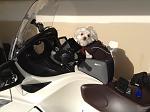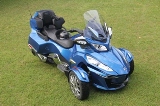|
-
 Tire gauge and pressure Tire gauge and pressure
I continue to read the importance of the correct pressure in tires. However, how do you get an accurate pressure reading? I have a half dozen traditional stick gauges (very inexpensive) and their readings are not very consistent as you would expect. I have a dial gauge, a digital gauge, and what I consider a more expensive digital gauge and the consistency again is not very good.
So if the “industry” thinks tire pressure is so important why does there seem to be such a discrepancy in gauges that routinely provide 10 to 15% variation in readings. I’m sure tire pressure varies considerably based on road temps, outside air temp, etc. So if you take into account environments conditions and inconsistent gauge reading which can easily provide pressure reading in the 10 to 15% range there must be a relative generous “acceptable” range for tire pressure.
-
Ozzie Ozzie Ozzie


Absolute 'accuracy' is not really all that important in a tire pressure gauge for most road going Spyder Ryders, but consistency is! 
If you check your tire pressures at about the same time each day, BEFORE you start riding/driving, and preferably before the sun starts heating one side or end of your vehicle more than the other, using a gauge that is consistent, it's going to give you a more reliable indication of how close you are to the ideal pressure for YOUR tires & the way you ride than you'd get by spending 20 mins trying to get your pressures matched to the third decimal place using the most accurate gauge known to mankind!  For most road users, there's no point in looking beyond the nearest whole number (or maybe 1 decimal place rounded up &/or down) when you're reading pounds per square inch, simply because your tire pressures might vary by as much as 3 or 4 psi just from sitting in the sun for 10-20 minutes or so, and there are a bunch of other variables that will change your pressures just as quickly, especially once you start riding! For most road users, there's no point in looking beyond the nearest whole number (or maybe 1 decimal place rounded up &/or down) when you're reading pounds per square inch, simply because your tire pressures might vary by as much as 3 or 4 psi just from sitting in the sun for 10-20 minutes or so, and there are a bunch of other variables that will change your pressures just as quickly, especially once you start riding! 
But beware, a tire that DOES NOT increase in pressure at all after 30-60 minutes of riding is OVER-INFLATED! Your tires NEED to heat up a little thru use, & that means their pressure needs to increase accordingly in order for them to work properly & grip the road properly, compromising your ride, handling, and braking; so if your tires don't heat up by about 4psi after 60 mins riding, you are starting out with their pressure set too high for the load & riding conditions! On the other end of the scale, if your tires are heating up & so increasing their pressure by much more than about 6-8psi after 30-60 mins riding, you are starting out with their pressure too low & you are risking catastrophic tire failure! 
So get yourself a tire pressure gauge that reliably reports the same reading for given pressure every time....(to within a 1/2 a psi is close enough!) Most readily available & not massively expensive 'stick gauges' simply won't do that, so generally, you won't find too many tire professionals using them these days. A good quality dial gauge that might be 1 or 2 psi off 'exactly accurate' but will consistently read a given pressure with the same error within +/- 1-2 psi every time is much more useful to you than the most accurate stick gauge or any other gauge that only hits that 'absolute accuracy' every now & then or only when it's used under a specified set of controlled conditions! A fairly robust, reasonably accurate, reasonable quality dial gauge or a good quality digital gauge that reads to 1 decimal place is going to be good enough for almost all regular road users driving and riding, even more so if you can check & adjust it accordingly against a 'known accurate & recently calibrated' professional pressure gauge once or maybe twice a year. 
And then you need to run any Kenda, Arachnid, or Vee Rubber tire at/within +/- 1-2 psi of the cold pressure stated on the tire placard, but never starting over the max pressure imprinted on their sidewalls - these lightweight tires NEED pressures within that range to carry the load your Spyder imposes on them - DO NOT EVER run them as low as you can run a 'normal' car tire!  If you fit any higher load & speed rated 'normal' car tires onto your Spyder, then you should run them at the appropriate 'pressure for load' indicated by the manufacturer (if you can access that info!) or at the pressures resulting from the 'ready reckoner' type calculation I've posted elsewhere; or failing that, just go for around 16 psi or so up front, 18 psi or so in the rear, and adjust up or down to suit YOUR ryding needs & wants, or as indicated by the 4psi Rule or 'chalking the tires', etc. If you fit any higher load & speed rated 'normal' car tires onto your Spyder, then you should run them at the appropriate 'pressure for load' indicated by the manufacturer (if you can access that info!) or at the pressures resulting from the 'ready reckoner' type calculation I've posted elsewhere; or failing that, just go for around 16 psi or so up front, 18 psi or so in the rear, and adjust up or down to suit YOUR ryding needs & wants, or as indicated by the 4psi Rule or 'chalking the tires', etc.
But remember, while those tire placard pressures for the Kendas etc, &/or the lower pressures suggested for stronger/heavier constructed 'normal' car tires are a good place to start, they are provided as 'general pressure advice' that 'should suit most' and are not necessarily taking into account any of the variations in load &/or use that you (or anyone else) might impose. So given that starting 'general pressure advice', it's then up to YOU to regularly monitor and adjust your tire pressures up or down within the indicated range to set the pressure that most suits YOUR riding/driving needs & wants! 
It's all simple really... 
Last edited by Peter Aawen; 12-19-2019 at 04:09 AM.
2013 RT Ltd Pearl White
Ryde More, Worry Less!
-

Peter
Thanks for the reply and information.
Poasttown
-
Active Member


 Originally Posted by Poasttown

I continue to read the importance of the correct pressure in tires. However, how do you get an accurate pressure reading? I have a half dozen traditional stick gauges (very inexpensive) and their readings are not very consistent as you would expect. I have a dial gauge, a digital gauge, and what I consider a more expensive digital gauge and the consistency again is not very good.
So if the “industry” thinks tire pressure is so important why does there seem to be such a discrepancy in gauges that routinely provide 10 to 15% variation in readings. I’m sure tire pressure varies considerably based on road temps, outside air temp, etc. So if you take into account environments conditions and inconsistent gauge reading which can easily provide pressure reading in the 10 to 15% range there must be a relative generous “acceptable” range for tire pressure.
Peter Aawan's post is spot on band there's been many tire pressure threads addressing those stick gauges. Follow the advice on avoiding them.
2011 Spyder RT-S
LtCol, USAF Ret
Proud Patriot Guard Rider
-
Very Active Member


One simple way to address repeatability on a collection of gauges is to measure a known pressure with all the gauges in your possession and dispose of the ones that don't agree with the majority. Measuring instruments by nature are most accurate in the 50% range, so measuring a tire with 18-25 PSI in it is best accomplished with a 50 or 60 PSI maximum gauge, not a 120 PSI gauge. I built my own using Wika brand gauges and adapted them to store bought chucks with bleeders.
h0gr1der
2018 RT Limited Blue/Chrome SE6 *Tri-Axis Bars*Adjustable Driver Backrest*175/55R15 Vredestein Front, 205/60R15 Vredestein Rear Tires*Baja Ron Front Spring Pre-Load Adjusters*Misty Mountain Sheepskin seat cover*Centramatic balancers *Garmin Zumo 595LM GPS*KOTT Grills*BajaRon swaybar*SpyderPops Alignment*Missing Belt guard*Magnetic Mirrors*Custom Rear Adjustable Shock*360° LED Headlights & Foglights*Progressive front fender turn signals
States Visited on Less than 4 wheels.

 Posting Permissions
Posting Permissions
- You may not post new threads
- You may not post replies
- You may not post attachments
- You may not edit your posts
-
Forum Rules
|




 Reply With Quote
Reply With Quote
 For most road users, there's no point in looking beyond the nearest whole number (or maybe 1 decimal place rounded up &/or down) when you're reading pounds per square inch, simply because your tire pressures might vary by as much as 3 or 4 psi just from sitting in the sun for 10-20 minutes or so, and there are a bunch of other variables that will change your pressures just as quickly, especially once you start riding!
For most road users, there's no point in looking beyond the nearest whole number (or maybe 1 decimal place rounded up &/or down) when you're reading pounds per square inch, simply because your tire pressures might vary by as much as 3 or 4 psi just from sitting in the sun for 10-20 minutes or so, and there are a bunch of other variables that will change your pressures just as quickly, especially once you start riding! 



